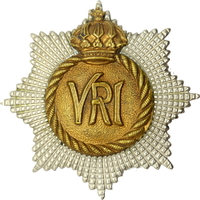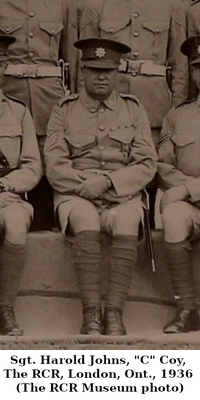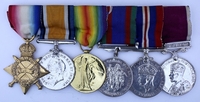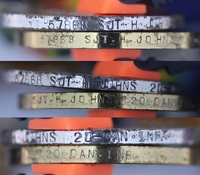
12719 CQMS Harold Johns
37th Regiment, Haldimand Rifles
20th Canadian Infantry Battalion
The Royal Canadian Regiment
Canadian Small Arms Training Centre
By: Capt (ret'd) Michael M. O'Leary, CD, The RCR
Harold Nicholas Johns was born in London, England, in 1894 or 1895. Sources offer various dates of birth, with two provided by him. His Canadian Expeditionary Force (C.E.F.) attestation paper gives a date of 7 Mar 1894, while his enrolment record on joining the Permanent Force in 1920 states 3 Jul 1895. Later records give his date of birth as 7 Mar 1895. An ancestry page agrees with the earlier year, but offers no month or day of birth. To add to the challenges of following Johns' trail, his surname has also been recorded in some records as "John."
Harold was the second child of William and Cordelia (nee Saunders) Johns, following older brother Dudley (b. 1891). Harold's mother died in 1895, the year of (or year after) his birth. William Johns remarried in 1896, taking as his second wife Rose Parry. Two more children were the result of this union, Leyshon (b. 1898) and Clifford (b. 1902).
Finding Harold and his family presented an interesting challenge since he offered the name of a next of kin in his First World War records, but specified no relationship. A search of almost 400 published sailing lists for the C.E.F. turned up one other soldier, Dudley Johns, who identified the same person as their next of kin. Returning to ancestry with Dudley's name resulted in a number of pages showing his family although most only listed an unnamed sibling. Checking every iteration of ancestry pages for Dudley's mother finally resulted in one depiction of the family that named both of her sons, Dudley and Harold. (This page is also the only appearance of a middle name for Johns, "Nicholas.")
On 15 Apr 1910, the S.S. Canada, a ship of the Dominion Line, disembarked passengers at Halifax, N.S., after crossing the Atlantic from Liverpool, Eng. Aboard was one "H. John" (sic), born "about 1894." Recorded in the passenger list as a farm labourer, Johns was heading for Toronto, Ont.
In the 1911 Canadian Census, we find Harold John (sic), a 17-year-old boarder living at 485 Talbot St., London, Ont. His month and year of birth were recorded as March 1895. Johns was employed as a shipper for H.T. Reason & Co., a paper box manufacturer and wholesale dealer in paper, twine and stationery. The census noted that Johns was English-born and his religious denomination was Baptist.
The next time we find Johns in available records is when he enlists as a soldier in the First World War. By 1914 he was apparently living in or near Cayuga, Ont., a town 20 kilometres south of Hamilton. The Post Office for this town shows up as an address on a 1919 dated envelope in his service records. Johns claimed to be a soldier of the 37th Regiment, Haldimand Rifles, and the 1914 Militia List shows that "B" Company of the 37th Regiment was located at Cayuga. A review of the paylists for the unit in 1914 for their attendance at the annual Militia Camp at Camp Niagara, 1-12 Jun 1914, does not include his name (neither does he appear in the preceding years). Johns' service records do not provide a length of service with the 37th Regiment, so he may have not attended the annual camp(s) or he enlisted with the unit after June 1914.
Harold Johns attested for service in the Canadian Expeditionary Force (C.E.F.) with the 20th Overseas Battalion at Toronto, Ont., on 12 Nov 1914. A 20-year-old farmer, Johns was described on his attestation paper as 5 feet 6 1/2 inches tall, weighing 141 pounds, with a 32 1/2-inch chest, a fair complexion, blue eyes, and brown hair. His religious denomination was Baptist. Johns identified William Johns, 111 Blytheswood Rd., Ilford, London, Eng., as his next of kin although his records do not specify their relationship. On attesting with the 20th Battalion, Johns was given the regimental number 57868.
The 20th Battalion, C.E.F., was an infantry battalion authorized on 7 Nov 1914. The unit recruited in central and northern Ontario and was mobilized at Toronto. The 20th Bn. embarked for Britain on 15 May 1915 and, after training in England, disembarked in France on 15 Sep 1915. The battalion fought as part of the 4th Canadian Infantry Brigade, 2nd Canadian Division, in France and Flanders.
Johns is shown in his records as "Overseas" as of 16 May 1915, the date after sailing from Montreal on the S.S. Megantic. His records also note that he disembarked Boulogne on 14 Sep 1915, the day prior to the unit officially landing. This, perhaps, shows that he was a member of an advance party that crossed on the preceding day.
Soon after arriving in the theatre of war, the 20th Battalion commences the cycle of front line trenches, support trenches, reserves, marching, and training that defined the life of infantry battalions on the Western Front. Few tours of the front lines were without casualties, and even when out of the most forward trenches, the reach of enemy artillery could take its toll.
On 26 Jul 1916, Johns completed a Military Form of Will in his paybook. On this document, he wrote: "In the event of my death I give the whole of my property and effects to Mr. W. Johns, 111 Blytheswood Rd., Goodmayes, Essex, England."
Johns lasted a year in and out of the trenches before his luck ran out. On 15 Sep 1916, the 20th Battalion was engaged in the assault at the Sugar Factory near Courcelette. Attacking and capturing as part of a larger operation, the Battalion's advance took place over a frontage of 250 yards to a depth of 1000 yards. Taking and holding their objective, the unit captured over 50 German prisoners, a machine gun and three howitzers. The cost to the 20th Battalion, recorded in the War Diary, was estimated the following day at 52 killed in action and 260 wounded.
On 16 Sep 1916, Johns was admitted to No. 5 Canadian Field Ambulance. While the rotation of infantry units through front line, support and reserve positions is familiar to many, the rotation of Field Ambulances through duty stations is less so. At this time, No. 5 C.F.A. was tasked with battlefield evacuations and its bearer parties were collecting wounded from the battlefield behind the advancing units.
Evacuated from the field, Johns was passed from No. 5 C.F.A. to No. 4 C.F.A. This Field Ambulance was operating Dressing Stations, stabilizing the incoming wounded and preparing them for further evacuation to Casualty Clearing Stations (C.C.S), to the Divisional Rest Station (D.R.S.), or a return to duty. Diagnosed with shell shock, Johns was transferred to the D.R.S. which was operated at the time by No. 10 Canadian Field Ambulance.
Johns was transferred again on 16 Sep 1916 and admitted to No. 3 C.C.S. at Remy. The heavy casualties noted in the War Diaries of the Field Ambulances during the ongoing operations at Courcelette probably accelerated Johns' movement rearward in the medical evacuation system. Not requiring immediate treatment, he was readily evacuated to the next facility as soon as the necessary transport was available. The following day he moved once again, this time to No. 35 C.C.S. at Doullens. He would stay here almost a week before his next transfer.
On 23 Sep 1916, Johns was transferred by Ambulance Train and admitted to No. 1 Convalescent Depot, Boulogne. The diagnosis recorded in his records notes "Shell shock and synovitis, right ankle."
Five days after his arrival in Boulogne, on 28 Sep 1916, Johns was pronounced "Fit" and discharged to Base Details. A few days later he was classified by a Medical Board as "Temporary Base." he remained at Boulogne until 20 Oct 1916 when he was given a medical category of "A," i.e, fit for active service, and rejoined the 20th Battalion in the field on 23 Oct 1916.
Johns was awarded a Good Conduct Badge on 12 Nov 1916. Six weeks later, on 24 Dec 1916, he was granted ten days leave, from which he rejoined the Battalion on 5 Jan 1917. There are two cash payments shown on John's pay records during this period of leave, taken on the 25th and 28th of December. These payments totaled $250.70 which represented about eight months' pay.
Commencing 22 Jul 1917, Johns was attached to 4 Field Company, Canadian Engineers. Over the following month, the Company with its attached infantry troops would be engaged in wiring new sections of the front, the construction of an Ammunition Refilling Point (A.R.P.) at Terris Siding, and a variety of construction tasks.
Shortly before his return to the 20th Bn., on 19 Aug 1917, Johns was appointed Lance Corporal vice 58196 L/Cpl Herbert Bodycomb, who was himself promoted. Johns' attachment with the 4th Fd. Coy. Ended on 23 Aug 1917 and he returned to unit.
On 12 Nov 1917, Johns was promoted Corporal, again replacing Herbert Bodycomb. This would be the last time Johns followed Bodycomb up the ranks of the battalion. Bodycomb was reported missing after action on 12 Nov 1917. A few months later it was confirmed that he had been captured and a was a Prisoner of War where he would remain until repatriated in December, 1918.
From 9 to 16 Dec 1917, Johns attended a training course in gas warfare. A few days after the course, on 20 Dec 1917, he was granted 14 days leave.
Johns' next interaction with the medical system came on 15 Feb 1918 when he was admitted to No. 6 C.F.A. suffering from periostitis of his lower jaw, an infection-caused inflammation of the connective tissue surrounding bone. Three days later, on 18 Feb 1918 he was evacuated to No. 4 C.F.A. which was in charge of the Canadian Corps Rest Station. Here he was treated for an alveolar, or dental, abscess. Johns was discharged from hospital and returned to duty on 24 Feb 1918.
On 11 Apr 1918, Johns was appointed Lance Sergeant. A few weeks later, on 1 May 1918 he was attached to the 4 Canadian Infantry Brigade Headquarters for duty with the Brigade Gas Officer from 1 to 6 May 1918. Johns left the unit lines gain at the end of that month when he was struck off strength on 30 May 1918 to the 2nd Divisional Wing of the Canadian Corps Reinforcement Camp (C.C.R.C.) on exchange.
Johns remained at the C.C.R.C. until 12 Aug 1918 when he was transferred to the 4th Canadian Infantry battalion. Leaving the C.C.R.C. on 14 Aug 1918, Johns joined the 4th Bn. in the field the next day.
A few day after arriving at the 4th Bn, Johns was promoted Sergeant on 18 Aug 1918. he would spend less than three weeks with the unit. On 6 Sep 1918, he was posted back to the 20th Cdn. Inf. Bn. Once these moves were completed, annotations in Johns' service record show that for official purposes he was posted to the 4th Bn. on 14 Aug and to the 20th Bn. the following day.
On 9 Oct 1918, the 20th Battalion moved into the Marcoing Line and prepared to join the 2nd Canadian Division's attack as the Canadian Corps enveloped Cambrai. Launching their attach at 6 a.m. on 10 Oct 1918, the battalion was fiercely engaged for two days attacking and holding newly taken ground. Relieved on 12 Oct 1918, the Battalion's War Diary summarized the cost of the two days of battle:
"Total casualties were 3 officers killed and 8 wounded, 29 other ranks killed and 210 wounded and 80 missing. The strength coming out of the line was 185, all ranks."
On 12 Oct 1918, Johns was admitted to No. 1 C.C.S. and transferred to No. 17 Ambulance Train. The following day he was admitted to 26 General Hospital, Etaples, suffering from multiple gun shot wounds (G.S.W.). In the medical usage at the time, G.S.W. could refer to wounds caused by bullets, shrapnel balls, or shell splinters. Six days later, on 19 Oct 1918, Johns was admitted to No. 6 Convalescent Depot, Etaples.
Johns continued moving rearward in the medical evacuation system. Battling the effects of his battlefield sounds, other diagnoses were added along the way. On 21 Oct 1918, he was transferred to No. 5 Convalescent Depot, Cayeux. A week later, on 28 Oct 1918, he was admitted to No. 3 Australian General Hospital with a diagnosis of influenza.
On 21 Nov 1918, Johns was evacuated to England on the hospital shop H.S. St. Denis and admitted to the County of Middlesex War Hospital, Napabury St., St. Albans, with pneumonia. Having been invalided sick and posted to England, his parent unit changed from the 20th Battalion to the 1st Central Ontario Regimental Depot (C.O.R.D.), Witley.
The 1st C.O.R.D. was part of the new regionally based reinforcement system, with named Depots taking in troops from battalions raised in those areas in Canada and providing reinforcement drafts to similarly designated fighting units. The 20th Cdn. Inf. Bn., having been originally raised in Toronto from men recruited in Ontario, was associated with the 1st C.O.R.D. These Depots also became the parent unit for any soldiers returned to England from their affiliated battalions in France and Flanders.
Johns, still suffering from bronchial pneumonia, was transferred to the Military Convalescent Hospital at Woodcote Park, Epsom, on 9 Jan 1919. he remained here two weeks before being discharge to the Depot on 27 Jan 1919. Two months later, on 17 Mar 1919, Johns was struck off the strength of the 3rd Reserve Battalion on proceeding to District Depot No. 2, Kinmel Park Camp, in preparations for his return to Canada.
One week after arriving at Kinmel Park, Johns embarked for Canada. Returning on "Sailing No. 36," Johns left Liverpool on 25 Mar 1919 aboard the H.M.T. Scotian and landed at St. John, N.B., on 4 Apr 1919. Once at sea, he was taken on the strength of No. 2 District Depot at Toronto.
Johns was only back in Canada for two days before his discharge was effected on 6 Apr 1919. At 24 years of age, Sergeant Harold Johns was discharged from His Majesty's Service at Toronto. His proposed place of residence on discharge was Cayuga, Ont.
On his release from service, Johns was given a War Service Badge Class "A" which an ex-soldier could wear to show potential employers or others that he had served. Imprinted with a warning that misuse could result in a fine, and individually numbered, Johns War Service badge was No. 148950.
Having rarely taken all of his pay, letting the remainder accrue in his pay account, Johns finished the war with a balance of $809.34 to his credit. On discharge, Johns was eligible to receive a War Service Gratuity of $420. Cheques were issued to him in five installments between April and August 1919.
It took less than a year for Johns to tire of civilian life and choose a return to uniformed service. On 15 Jan 1920, Johns enlisted in the Canadian Permanent Force with the Royal Canadian Regiment at Toronto, Ont. A 24-year-old dry goods clerk, his date of birth was recorded in the Regiment's enlistment ledgers as 3 Jul 1895.
For his service in the C.E.F., Johns was entitled to receive the 1914-15 Star, the British War Medal, and the Victory Medal. The medal card in his CEF service record was first filed with the address reading "Cayuga P.O., Ont." After his enlistment in the Permanent Force this was changed to reflect his new pl;ace of residence. Johns' medals were despatched to him care of the Officer I/C Records, Headquarters, the R.C.R., Halifax, N.S., on 12 Nov 1921.
The London Free Press, in its edition on 12 Jan 1924, noted Johns' promotion and a posting to London, Ont.:
"Military Promotions
"Promotions in The Royal Canadian Regiment officially announced yesterday on headquarters' orders include C.Q.M.S. S.T. Flanberg, D.C.M., to regimental quartermaster sergeant at London, from Halifax. Corpl. Johns is posted to "C" Company, London, as sergeant."
Noted in the September and December, 1927, editions of the regimental journal, The Connecting File, Johns attended a course of instruction at the Canadian Small Arms School, Long Branch, Ont. With three other non-commissioned officers from the Regiment, he successfully completed the "A" Wing training course for Other Ranks. This training prepared him for tasks or employment as a small arms instructor.
The October, 1929, edition of The Connecting File included the following under "D" Company Notes, indicating that he had once again changed regimental garrisons and was at St John's, Que., with "D" Company of The RCR:
"A Camp School of Infantry was held from the 2nd to the 17th of July. Capt. H.M. Logan was chief instructor. The following were assistant instructors:– Serjt. J.H. Bazley: Serjt. S. Rayner, M.M.; Cpl. L. Lafond, Cpl. H. Bond, L/Cpl. J. Chapman, L/Cpl. T. Rowlands, Pte. O. Battle, Pte. C. E. Ward, Pte. O.S. Lewis and Pte. C.E. Lafond. Serjt. H. Johns acted as Camp Q.M.S."
Effective 1 Sep 1930, Johns was transferred again, this time from "D" Company at St John's, Que., to "A" Company at Halifax. The January, 1931, edition of The Connecting File included the following under "A" Company Notes:
"Serjt. H. Johns has been appointed manager of the Basketball Team. His team has had only one tie against them, all the rest have been wins. Further particulars regarding the actual play of the various matches will be recorded at the conclusion of the league, probably next issue."
On 7 Feb 1931, Johns was appointed Acting Company-Quartermaster-Serjeant, with pay. He was confirmed in the appointment of C.Q.M.S. on 22 Mar 1933.
Johns is mentioned in the first volume of regimental history published by The RCR (Fetherstonhaugh, 1936) for his role in the depositing of a regimental banner in the garrison church in Halifax. Taking place on 22 Oct 1933, and set in context to the previous year's laying up of the Regiment's first stand of Colours in London, Ont., the history relates:
"Similar in many respects were the honours paid in the autumn of the following year, 1933, when a banner presented to the Regiment by His Majesty King George V to commemorate the services of its Expeditionary Force battalion in the Great War was deposited in St. Mark's Church, Halifax. On this occasion, "A" Coy. paraded, under the command of Major H.T. Cock, M.C.; 85 Old Comrades paraded, under the command of Lieut.-Col. E.K. Eaton; and Major M.F. Gregg, V.C., M.C., was appointed to carry the banner, with Coy. Sergt.-Major R.E. Lawrence and Coy. Quartermaster-Sergeant Harold Johns as escort. In the presence of the Lieutenant-Governor of Nova Scotia, the Mayor of Halifax, and a notable gathering, the banner was deposited, Major the Reverend G.W. Bullock, an overseas chaplain of the unit, accepting it, with the assurance that in St. Mark's it would find an appropriate and honoured sanctuary."
Throughout his career, Johns maintained his military skill set. In the April, 1935, issue of The Connecting File, his performance at the rifle range was noted. Identified as a member of "C" Company, it is apparent that Johns had again relocated, to the regimental station at Wolseley Barracks, London, Ont.:
"Annual Weapon Training, 1934:– The undermentioned qualified in Annual Weapon Training, 1934, as BEST SHOTS of The Royal Canadian Regiment in their respective classes:– No. 12719, Serjeant H. Johns, "C" Company."
The January, 1937, edition of The Connecting File provided two mentions of Johns under the "Headquarters Notes":
"Congratulations to S.M.I. H.M. Bevis, Serjeant H. Johns, Bdsm. F.C. Thomas and W. Thomas, on having been awarded Long Service Medals, which were presented by Brigadier J.C. Stewart, D.S.O., at his annual inspection."
"We regret the departure to pension of Serjt. H. Johns who leaves us after 22 years' service. A few of his intimate friends and honorary members of the Serjeants' Mess gave a little party in his honour and presented him with a small gift on his leaving. The members of the Serjeants' Mess also presented him with a token of their appreciation and esteem."
Johns' discharge from the Permanent Force is recorded in the regimental enrolment ledgers held in the archives of The Royal Canadian Regiment Museum. His entry notes his discharge was claimed under the terms of the Militia Pension Act on 26 May 1937. At the rank of Sergeant and holding the appointment of Company Quartermaster Sergeant, Johns' character on discharge was recorded as "Exemplary."
A little more than two years after Johns' discharge to pension, the world was again at war. Johns' medal group includes the Canadian Volunteer Service Medal and 1939-45 War Medal indicating a return to service during the Second World War. A query to Library and Archives Canada confirmed Johns' re-enlistment and a new service number, B100047. This service number is from a block of numbers assigned to enlistments for the Canadian Small Arms Training Centre at Long Branch, Ont.
Details of Harold John's life during and after the Second World War are yet to be confirmed. Perhaps the future acquisition of his Second World War service record will provide the next information in adding to his story.
Pro Patria
Visit a randomly selected page in The O'Leary Collection (or reload for another choice):
- The O'Leary Collection; Medals of The Royal Canadian Regiment.
- Researching Canadian Soldiers of the First World War
- Researching The Royal Canadian Regiment
- The RCR in the First World War
- Badges of The RCR
- The Senior Subaltern
- The Minute Book (blog)
- Rogue Papers
- Tactical Primers
- The Regimental Library
- Battle Honours
- Perpetuation of the CEF
- A Miscellany
- Quotes
- The Frontenac Times
- Site Map
QUICK LINKS
The O'Leary Collection—Medals of The Royal Canadian Regiment
Newest additions:
![]()
![]() SB-12725 Private Henry "Hank" Ard
SB-12725 Private Henry "Hank" Ard ![]()
WIA at Hill 187, Died of Wounds in Japan
![]()
![]() 2355331 Lance Corporal Albert Lorking
2355331 Lance Corporal Albert Lorking
Wounded in action, later a War Amps representative.
![]()
![]() 4334 / 477996 Pte Isaac Hamilton Wilcox
4334 / 477996 Pte Isaac Hamilton Wilcox
Permanent Force, South Africa, and C.E.F.
![]()
![]() 477019 Private Harold Ashcroft
477019 Private Harold Ashcroft
Transferred to the Tunnelers.
![]()
![]() 734231 Private Clark D. Thompson
734231 Private Clark D. Thompson ![]()
The older Thompson brother, killed in action.
![]()
![]() 733849 Private Norman Parker Thompson
733849 Private Norman Parker Thompson
The younger Thompson brother; post-war service in the Special Guard.
![]()
![]()
![]() A305 / 400305 Private Andrew Walker
A305 / 400305 Private Andrew Walker ![]()
"Previously reported Wounded, now Killed in Action."
![]()
![]() 823298 Pte Thomas Patrick Steele, M.M.
823298 Pte Thomas Patrick Steele, M.M. ![]()
… for gallant conduct in the field …
![]()
![]() P13066 Sergeant Harold Thompson
P13066 Sergeant Harold Thompson
Instrumental Soloist for over 20 years of Canadian Army service.
![]()
![]() 9609 / 477728 Private Albert Edward Piper
9609 / 477728 Private Albert Edward Piper
"Arrived from England as a STOWAWAY …"






